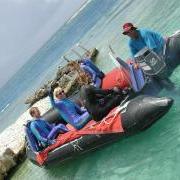In the heart of the South Pacific lies the tropical island of Rangiroa, one of the world’s largest atolls with an abundance of marine life including manta rays, sea turtles, and sharks

At the northern end of the Tuamotu Archipelago of French Polynesia lies Rangiroa atoll, a popular destination for divers due to its beautiful reefs, abundant fish and healthy shark populations. Rising only ten feet above sea level and with no access to running water, the livelihoods of those living on Rangiroa depends entirely upon the health and abundance of the surrounding sea.
Rangiroa is a secluded coral atoll in the middle of the South Pacific. Millions of years ago, volcanic activity created the island of Rangiroa, and after millennia, the center landmass receded into the sea. Now, what remains is the circular outer reef formed by centuries of coral build-up surrounding a central shallow lagoon. Due to its isolation, Rangiroa is home to pristine coral reefs and huge abundances of marine life including dolphins, sharks, tunas, and more.
My team and I traveled to this remote paradise to meet the oceans top predators, sharks, face-to-face. We journeyed here due to the huge congregation of sharks that gather at two major passes, Avatoru and Tiputa Pass. These major passes connect the inland lagoon to the vast ocean, and can be dangerous place for divers as strong currents push nutrients and fish from the inner lagoon out to the open sea. Sharks often wait near these passes for the strong currents to reveal a bounty of food. Here, we documented one of natures great wildlife gatherings for our PBS special, Jean-Michel Cousteau’s Ocean Adventures – Sharks at Risk. We were reminded of the harshness of nature but left with the knowledge of a key principle that nothing in nature is wasted.
State of Rangiroa
- Despite local efforts for limits on fishing, declines of fish populations continue in Rangiroa.
- Increases in the number of foreign long-lining vessels remove valuable resources for the local community, targeting the tunas and other pelagic species.
- As fisheries resources are becoming more stressed, some local fishermen are turning to hunting sharks for their fins as the global demand for shark fins rise.
- Rangiroa’s economy relies on a healthy marine environment for their productive fisheries, pearl oyster farms, and drawing in tourists and divers who want to witness their undersea abundances of marine life.
 The Rangiroa Expedition Team |
 Videos from Rangiroa |
Learn more about our work in Rangiroa
- Watch our PBS documentary series Jean-Michel Cousteau’s Ocean Adventures – Sharks at Risk.
- More countries are beginning to see the economic advantage of keeping sharks alive as tourism increases around the world, read Jean-Michel Cousteau’s blog on shark sanctuaries around the world in A Turning Point for Sharks.
- Jean-Michel strongly advocates for the protection of sharks and an end to shark finning and banning of shark fin products, learn more at Sharks at Risk.

Quick Facts
- Rangiroa is the largest of the Tuamotu Atolls and the second largest in the world.
- There is one main road on the island that runs 3.5 kilometers between Tiputa and Avatoru Pass.
- Rangiroa means “vast sky” in the local language of Tuamotuan.
Support Ocean Futures Society!
We rely on your support to help us be a Voice for the Ocean. By becoming a member, donating, or taking part in our Action Alerts, you help us spread our message, “Protect the Ocean, and you protect yourself, and future generations to come.”
Exploration
Donate to Two Futures Society
Yes! I want to support the field work, projects and mission of Jean-Michel Cousteau and the OFS team. Make a tax-deductible donation now!
Become a Member
Yes! Sign me up for a free membership!

Connect With Us